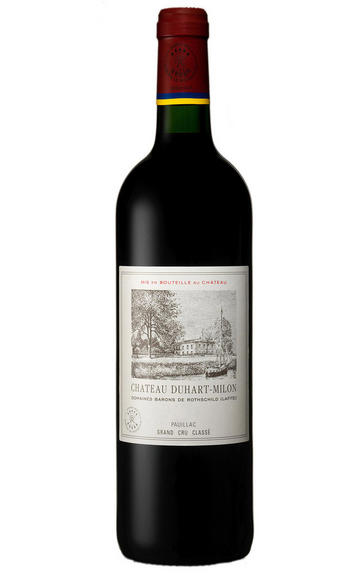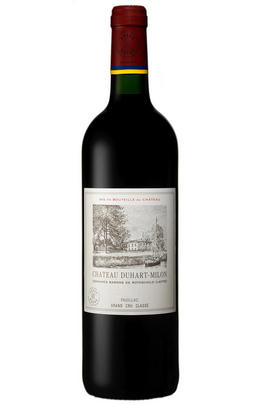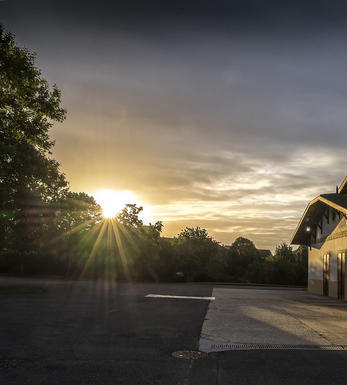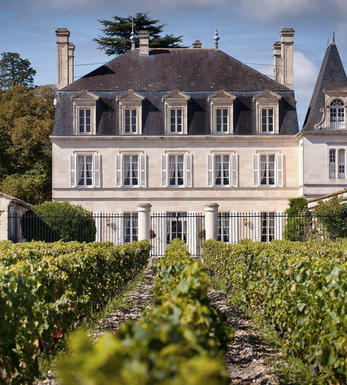
2020 Château Duhart-Milon, Pauillac, Bordeaux

Critics reviews
The 2020 Duhart-Milon has a delightful, elegant bouquet, an almost equal mixture of red and black fruit laced with sous-bois, cigar box and touches of curry leaf in the background. It is a little timid at first, but it seemed to grow over the 90 minutes I observed this wine. The palate is medium-bodied with supple tannins, a slightly fleshier Duhart-Milon compared to the obdurate, tannic wines of yore. It is gentle in some ways, revealing elegant brambly red fruit mixed with cedar and mint on the finish. Fine, although I would have liked just a tad more grip and heft.
Drink 2027 - 2050
Neal Martin, Vinous.com (May 2021)
The 2020 Duhart-Milon is soft, pliant and wonderfully seductive. Strong Cabernet aromatics open first, lending quite a bit of savory nuance. Bright red/purplish berry fruit, spice, cedar and earthy notes show the vibrant side of this Pauillac's personality. The 2020 deftly balances ripeness with energy. It's a terrific example of the year. Yields were 36.5 hectoliters per hectare, more or less in line with the recent past. The 2020 is the first vintage made in the new cellar.
Drink 2028 - 2040
Antonio Galloni, Vinous.com (June 2021)
Restrained and sombre at first, but carefully constructed, with a rippling muscular texture, full of firm tannins with bright acidities underneath. Like the precision and the slightly austere cool blue fruits, pencil lead and liquorice root. Elegant, precise, feels very Pauillac in its density combined with fine tannins that have life and lift on the finish. Harvest September 9 to 29. First vintage in the new cellar.
Drink 2028 - 2042
Jane Anson, Decanter.com (April 2021)
Deep garnet-purple colored, the 2020 Duhart-Milon comes skipping out of the glass with vibrant notes of crushed black cherries, black raspberries and plum preserves, plus an exotic spice undercurrent of cumin seed, star anise and cardamom, with an earthy touch of black truffles. The medium-bodied palate delivers mouth-coating, juicy black fruits with a plush texture and just enough freshness, finishing long and spicy.
Drink 2024 - 2039
Lisa Perrotti-Brown MW, Wine Advocate (May 2021)
Power and definition but elegance as well. Tight and retrained initially then opens to blackcurrant with aeration. Fruit dense on the palate, a profusion of super-fine tannins providing a velvety texture as well as freshness. Long ageing. Possibly the best Duhart yet.
Drink 2028 - 2045
James Lawther MW, JancisRobinson.com (May 2021)
72% Cabernet Sauvignon and 28% Merlot.
This is so refined with beautiful currant, berry and some subtle chocolate and coffee. It’s full and very subtle with fine tannins that have a long finish. Such purity and finesse with structure. Fresh and savoury.
James Suckling, JamesSuckling.com (April 2021)
Lots of tobacco, damp earth, chocolate, and lead pencil notes define the 2020 Château Duhart-Milon. Medium to full-bodied, it has a beautifully balanced mouthfeel, loads of blue and black fruits, and ripe yet certainly present tannins. Its relatively plush, rounded style is not too dissimilar from the 2016, but it offers ample structure as well. The blend is 72% Cabernet Sauvignon and 28% Merlot, and it hit 13% natural alcohol. This is another classic, concentrated, impressive wine from this team.
Drink 2027 - 2047
Jeb Dunnuck, JebDunnuck.com (May 2021)
Dense, mineral-etched, fine Cabernet Sauvignon nose; full but restrained in proportions, fresh in acidity, very fine in tannin, a lovely harmonious balance; freshly, sweetly ripe, long and fine-textured to taste, restrained in the Lafite mode, remarkably supple, full of ease and charm, but no lack of class, with a fine, almost stony, mineral background and superb length. A most complete, understated Duhart, with effortlesssly integrated acidity and beautiful tannins. So fine-textured that it will be accessible relatively early. A first-rate expression of the year.
Drink 2028 - 2040
Michael Schuster, The World of Fine Wine (May 2021)
About this WINE

Chateau Duhart-Milon
Château Duhart Milon is a Pauillac estate owned by Domaines Barons de Rothschild that produces on average 28,000 cases of wine per year. The wine chais are located in Pauillac town and the property has a similar climate to that enjoyed by the Médoc: maritime, with the Gironde estuary and the Bay of Biscay combining to act as a climate regulator and the coastal pine forests sheltering the vines from the westerly and north-westerly winds.
Duhart Milon Rothschild's vineyards (Cabernet Sauvignon 65%, Merlot 30%and Cabernet Franc 5%) border Lafite Rothschild. Vinification includes oak ageing, up to 40% new.
Duhart Milon Rothschild is classified as a 4ème Cru Classé.

Pauillac
Pauillac is the aristocrat of the Médoc boasting boasting 75 percent of the region’s First Growths and with Grand Cru Classés representing 84 percent of Pauillac's production.
For a small town, surrounded by so many familiar and regal names, Pauillac imparts a slightly seedy impression. There are no grand hotels or restaurants – with the honourable exception of the establishments owned by Jean-Michel Cazes – rather a small port and yacht harbour, and a dominant petrochemical plant.
Yet outside the town, , there is arguably the greatest concentration of fabulous vineyards throughout all Bordeaux, including three of the five First Growths. Bordering St Estèphe to the north and St Julien to the south, Pauillac has fine, deep gravel soils with important iron and marl deposits, and a subtle, softly-rolling landscape, cut by a series of small streams running into the Gironde. The vineyards are located on two gravel-rich plateaux, one to the northwest of the town of Pauillac and the other to the south, with the vines reaching a greater depth than anywhere else in the Médoc.
Pauillac's first growths each have their own unique characteristics; Lafite Rothschild, tucked in the northern part of Pauillac on the St Estèphe border, produces Pauillac's most aromatically complex and subtly-flavoured wine. Mouton Rothschild's vineyards lie on a well-drained gravel ridge and - with its high percentage of Cabernet Sauvignon - can produce (in its best years) Pauillac's most decadently rich, fleshy and exotic wine.
Latour, arguably Bordeaux's most consistent First Growth, is located in southern Pauillac next to St Julien. Its soil is gravel-rich with superb drainage, and Latour's vines penetrate as far as five metres into the soil. It produces perhaps the most long-lived wines of the Médoc.
Recommended Châteaux
Ch. Lafite-Rothschild, Ch. Latour, Ch. Mouton-Rothschild, Ch. Pichon-Longueville Baron, Ch. Pichon Longueville Comtesse de Lalande, Ch. Lynch-Bages, Ch. Grand-Puy-Lacoste, Ch, Pontet-Canet, Les Forts de Latour, Ch. Haut-Batailley, Ch. Batailley, Ch. Haut-Bages Libéral.

Cabernet Sauvignon Blend
Cabernet Sauvignon lends itself particularly well in blends with Merlot. This is actually the archetypal Bordeaux blend, though in different proportions in the sub-regions and sometimes topped up with Cabernet Franc, Malbec, and Petit Verdot.
In the Médoc and Graves the percentage of Cabernet Sauvignon in the blend can range from 95% (Mouton-Rothschild) to as low as 40%. It is particularly suited to the dry, warm, free- draining, gravel-rich soils and is responsible for the redolent cassis characteristics as well as the depth of colour, tannic structure and pronounced acidity of Médoc wines. However 100% Cabernet Sauvignon wines can be slightly hollow-tasting in the middle palate and Merlot with its generous, fleshy fruit flavours acts as a perfect foil by filling in this cavity.
In St-Emilion and Pomerol, the blends are Merlot dominated as Cabernet Sauvignon can struggle to ripen there - when it is included, it adds structure and body to the wine. Sassicaia is the most famous Bordeaux blend in Italy and has spawned many imitations, whereby the blend is now firmly established in the New World and particularly in California and Australia.


Buying options
Add to wishlist
Description
Cabernet Sauvignon 72%, Merlot 28%.
This is the first vintage in Duhart’s new cellar, featuring gravity flow and fermentation tanks individually tailored to each plot. This yields a more diverse palette from which to create the final blend. Factor in the superb quality and fruit health in 2020 and this is the most complex Duhart yet. The bouquet is assertive, but not overpowered by the black fruits. The palate carries a wonderful counterpoint between the wine’s juicy, fresh plumpness, and the fine-grained, gravelly tannins. This remains a little aloof, but its highlights are pin-sharp.
Drink 2026 - 2040
Berry Bros. & Rudd
wine at a glance
Delivery and quality guarantee